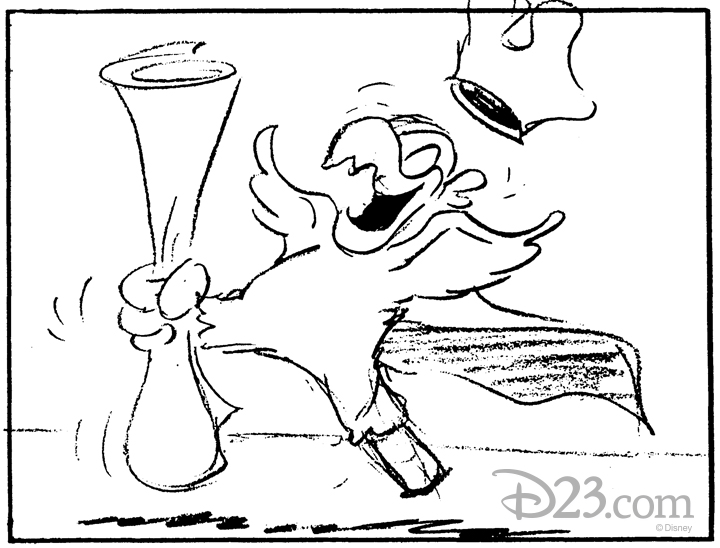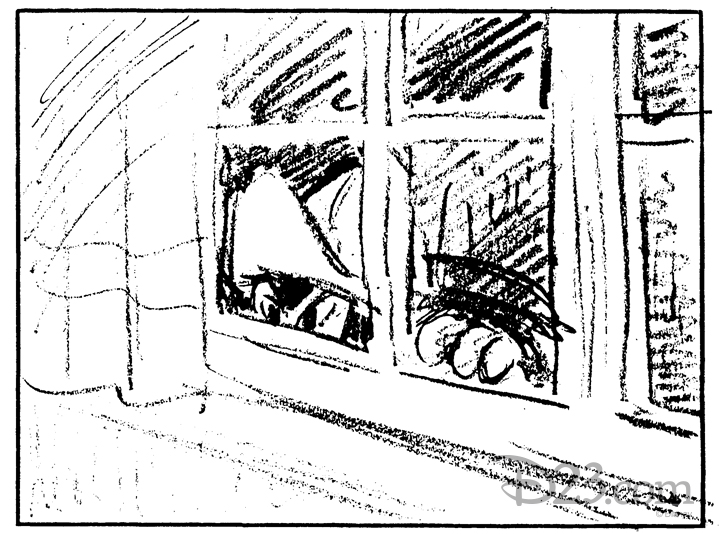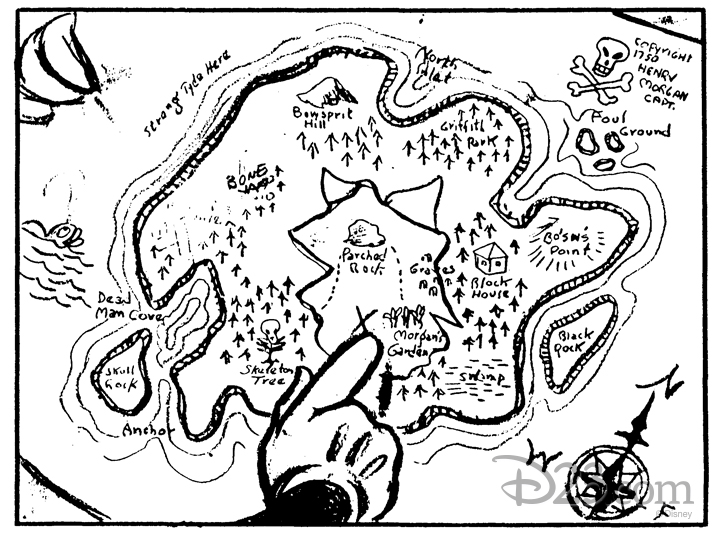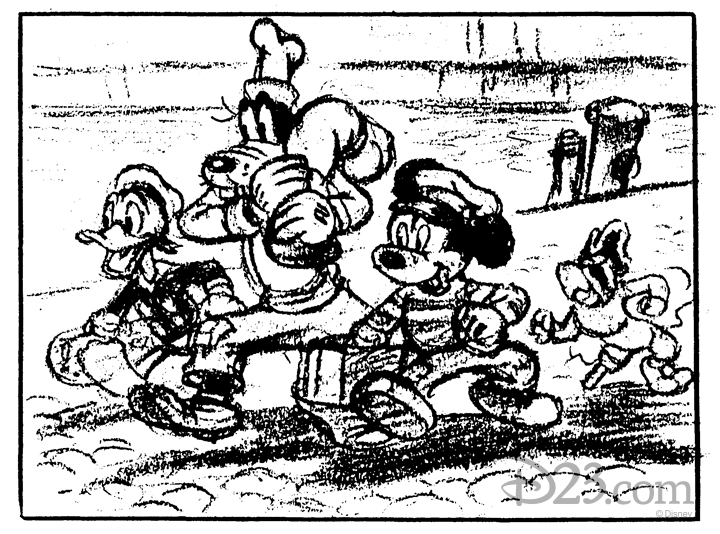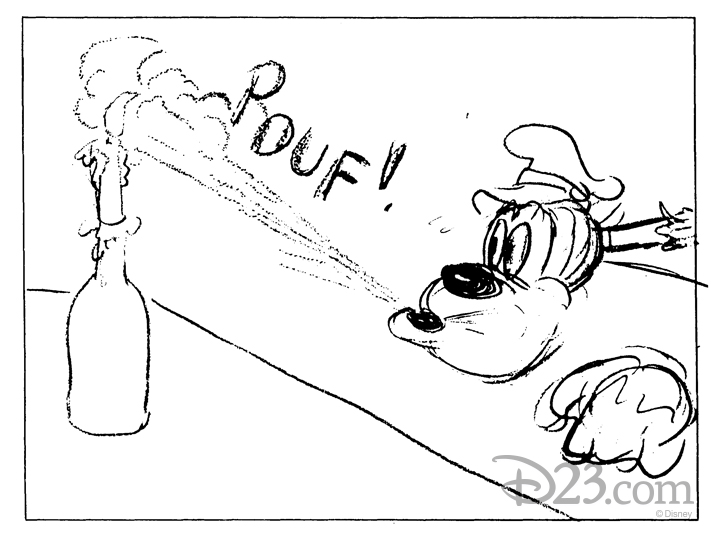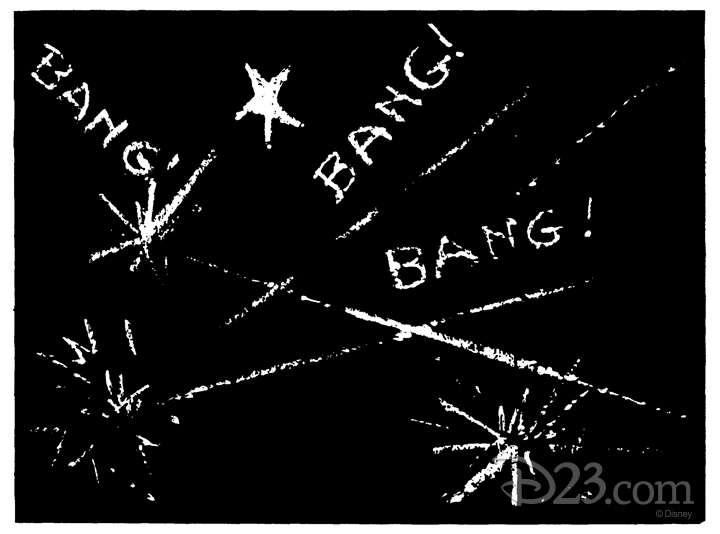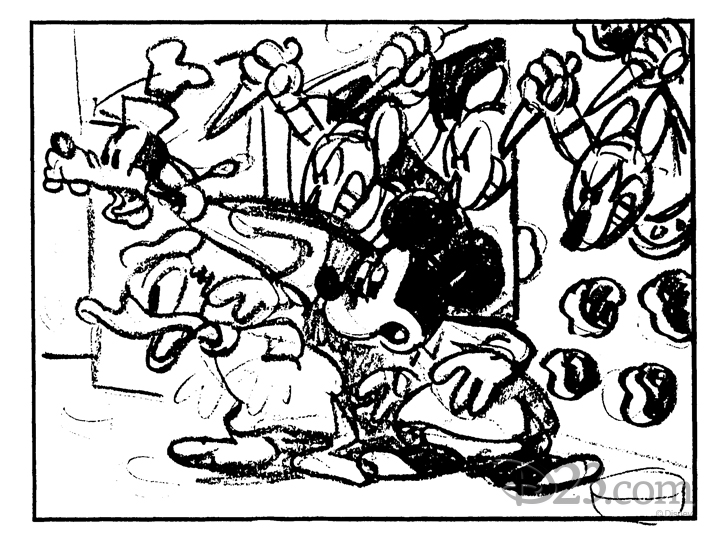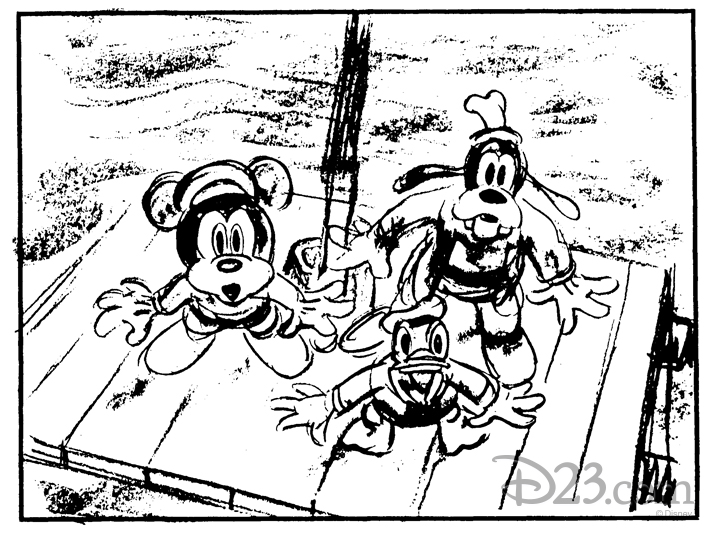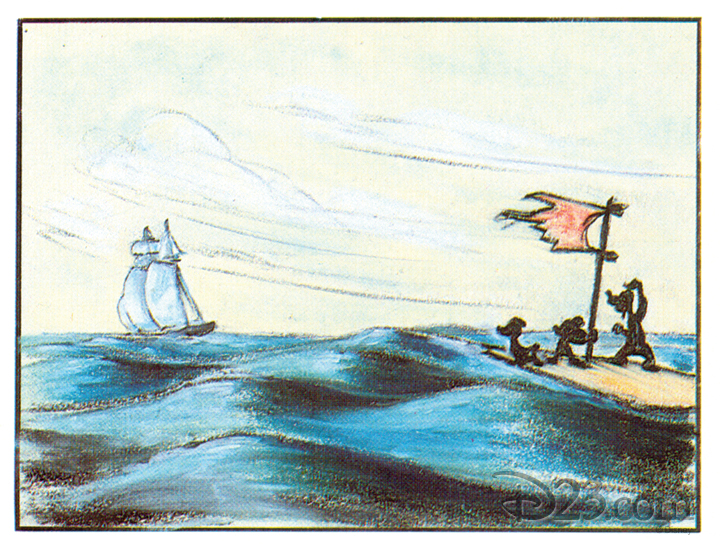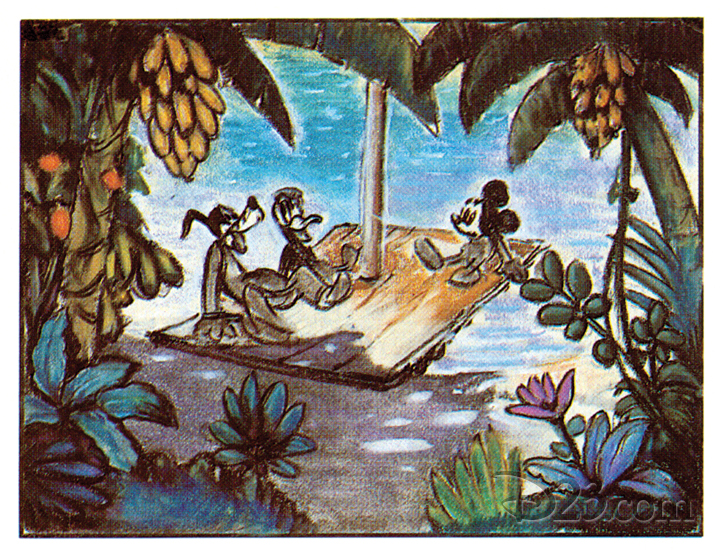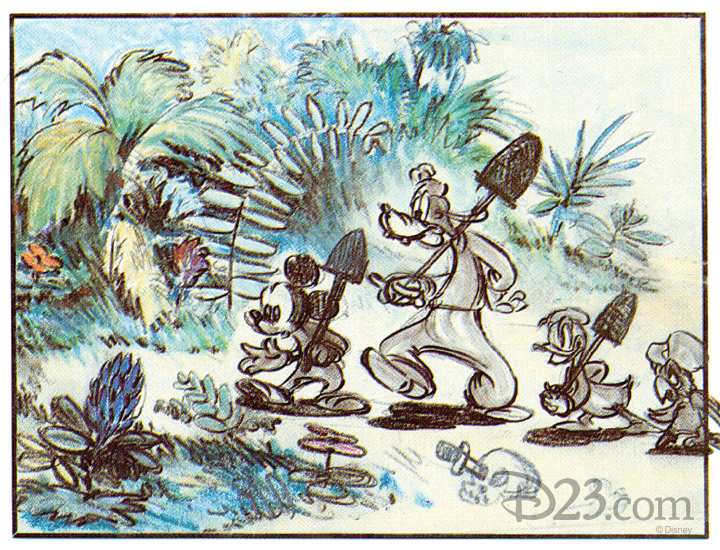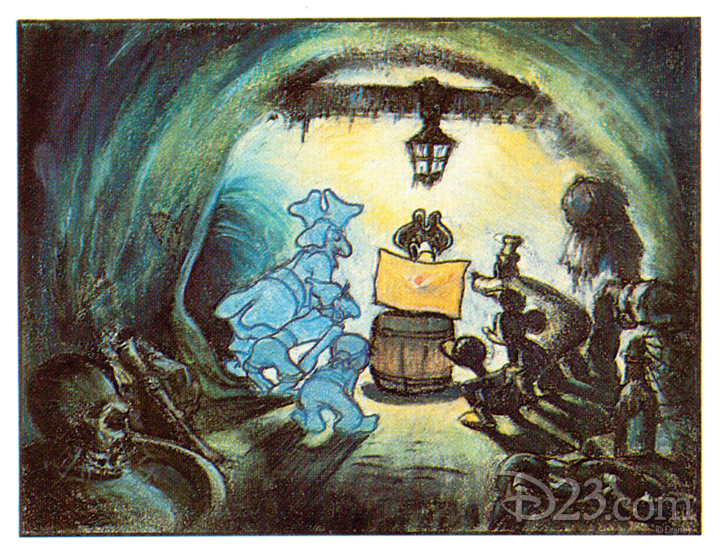This silent footage—the first ride-through of Disneyland’s Pirates of the Caribbean, as captured on film on December 2, 1966—was never seen by the public until our D23 Fanniversary events across the country in 2012. The film footage was discovered when film archivists at the Disney Studio were looking for unseen footage in preparation for Disneyland’s 50th anniversary. Pirates of the Caribbean eventually opened at Disneyland on March 18, 1967, and has since become one of the most popular Disney attractions ever created.
See Concept Art From Shanghai Disneyland’s Treasure Cove
On this day in 1967, Pirates of the Caribbean debuted at Disneyland in Anaheim. Nearly 50 years later, as part of The Walt Disney Company Annual Meeting of Shareholders, Disney chairman and CEO Bob Iger unveiled creative details including the first-ever Pirates-themed land and a new Pirates of the Caribbean attraction designed for the Shanghai Disney Resort.
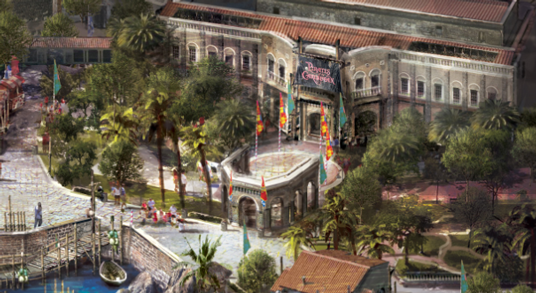
“Pirates of the Caribbean” is one of the most iconic attractions in our parks, and we really couldn’t imagine Shanghai Disneyland without Pirates,” said Bob Iger, Disney chairman and CEO. “We wanted to create a one-of-a-kind experience that would appeal to our Chinese guests while remaining true to its Disney heritage.”
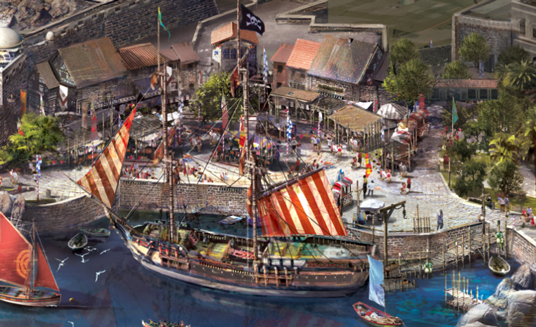
For the first time ever, a Disney Park will be home to a Pirates-themed land—Treasure Cove—and an e-ticket attraction called Pirates of the Caribbean: Battle of the Sunken Treasure. The attraction will feature a combination of new technology and innovation to bring guests along a pirate adventure with Captain Jack Sparrow and Captain Davy Jones, providing our guests who visit the Shanghai Disneyland Park an experience unlike anything else in the world.
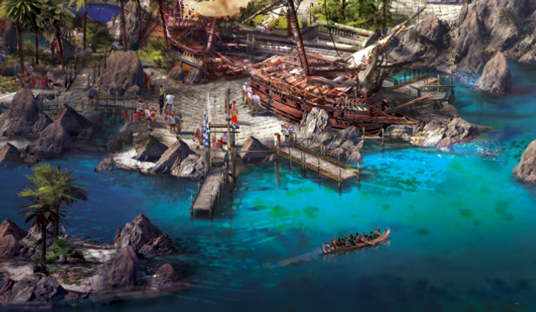
“We are extremely proud of all the work underway to bring the Shanghai Disney Resort to life,” said Tom Staggs, Chairman of Walt Disney Parks and Resorts. “And we’re excited to re-imagine the iconic world and characters of Pirates for the first time as an entire land that celebrates the creativity, imagination and adventure of both the fan favorite attraction and the popular film franchise.”

The announcement coincides with the completion of key structural work on the Pirates attraction, and marks another exciting milestone in the resort development. Progress continues with construction and Shanghai Disney Resort remains on target to open by the end of 2015.
Hidden Fan Tributes Inside Epcot’s Test Track
D23: The Official Disney Fan Club talks with Imagineers Melissa Jeselnick (assistant project manager) and Daniel Joseph (special effects designer) about the innovative design, Illusioneering, and hidden tributes to the past in Test Track Presented by Chevrolet.
The Design Experience
Responsiveness. Efficiency. Capability. Power. These are the four key design concepts of the re-imagined Test Track, Disney’s most immersive interactive Epcot attraction to date. Test Track explores Chevrolet’s design story through a behind-the-scenes look at the automotive design process, allowing guests to design their own virtual concept and then embark on a thrilling journey into a dazzling multi-sensory experience. “The attraction is inspires a new generation of designers—whether they want to go into automotive design or theme park design—introducing our guests, and especially kids, to those principles of design and making design choices,” Melissa explains.
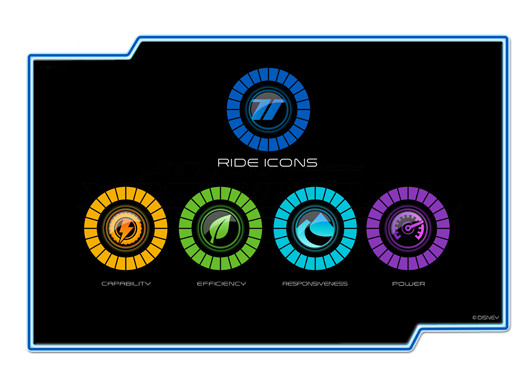
In the pre-show area, guests learn about the design process and are invited to virtual-draw their own concept, which performs against four key performance attributes. Melissa reveals that there are “trillions of different possibilities” for each designer, who can customize their concept to reflect their personalities and interests. Since design customization is such a vital component to the attraction, even single-rider guests have an opportunity to participate in an abbreviated design experience.
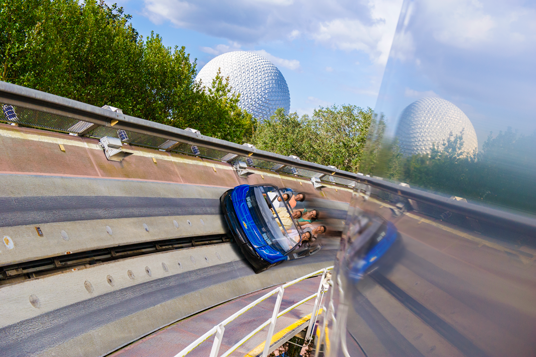
Guests test out their designs in the thrilling experience to follow, as the six-person SimCar ride vehicle transports them through an optically charged world comprised of four different testing zones, culminating in the high-speed loop around the Epcot pavilion. The Chevrolet design experience continues in an interactive post-show area that allows guests to discover just how well their designs withstood the performance tests, see how they performed against fellow designers, and take part in a series of all-new interactive experiences.
Keep Moving Forward
Matching the spirit of the original Epcot Center, Test Track reflects the forward-thinking attitude that inspired Imagineers to create a showcase to the world of new technologies and systems. Featured in the pre-show to the attraction is the latest visual technology pioneered by Imagineers: a series of multiplane LCD screens. Daniel, who showcased the history of “Epcot Illusioneering” at D23’s Epcot 30th Anniversary Celebration, explains that the innovation works as a reverse effect of the Disney Studio’s original multiplane camera developed in 1937. “Instead of a camera looking through layers of animation cels, we have two layers of video screen and a transparent video screen layered on top of each other playing two planes of video,” Daniel describes. The result is a remarkable dimensional effect without even needing 3D glasses.
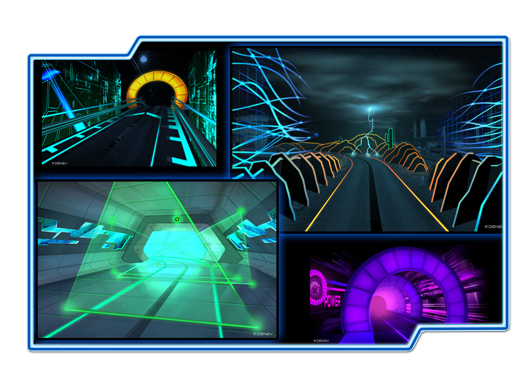
Inspired by the rich history of innovative special effects and illusions created by the Disney Studio and at Walt Disney Imagineering, Daniel affirms that the Illusioneering team strove to follow in the footsteps of Disney Legend and master illusioneer Yale Gracey, creating all-new effects for the attraction that are “simple, elegant, and repeatable.” Along their journey, guests will encounter lightning, fog, lasers, and an entire futuristic cityscape that support the multi-sensory ride experience.
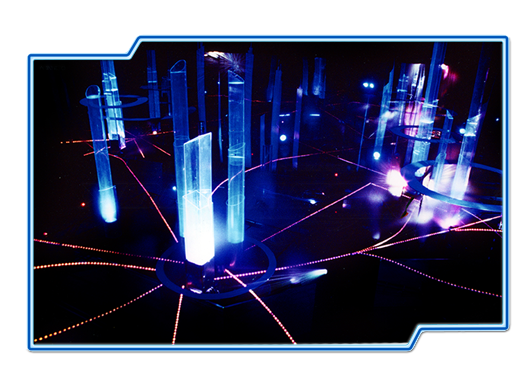
Looking Back at Tomorrow
This futuristic city scene that guests will see is actually a serendipitous, but accidental, tribute to Epcot’s original World of Motion attraction, Daniel reveals. Designed by Mike Overman, art director, who had not experienced the original incarnation of the transportation pavilion, the cityscape bears a remarkable resemblance to World of Motion’s futuristic CenterCore finale, which featured an inspiring vista of a bustling futuristic metropolis “on the move.”
“As the team built off of the city concept art, it arrived in a totally organic way, looking almost identical to the original city but in a new and forward-thinking technological manner to that original notion of this cool, moving, bustling city of tomorrow,” Daniel shares. “It was almost like the ride guided us there.”
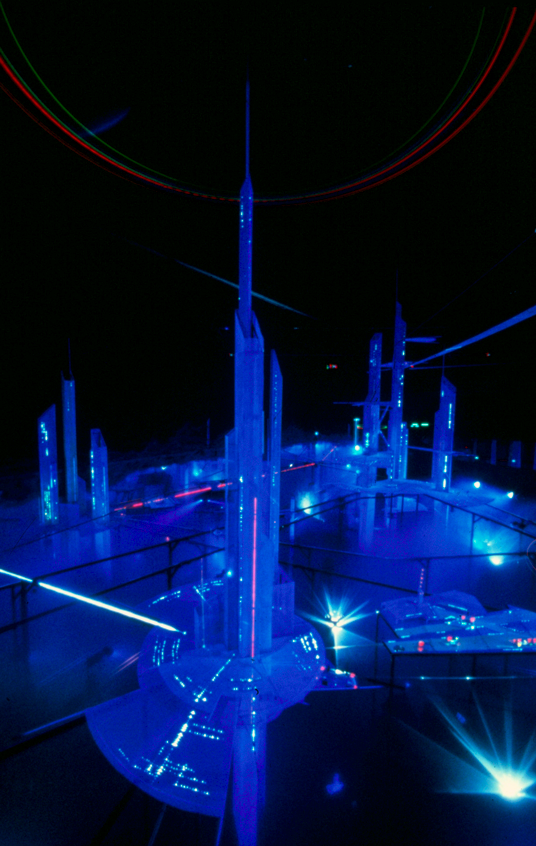
Keen eyes can spot references to both World of Motion and the original Test Track attractions throughout the updated experience. A sign found in the performance track identifies “Motion Drive,” “General Motor Way,” and “Chevy Lane,” a tribute to the three experiences that have resided in the building. “There are also a few nice World of Motion pavilion logos throughout the show as hidden homages,” adds Daniel, who was inspired by the original attraction growing up.
Guests who remember World of Motion may also recognize the reference to its musical theme, “It’s Fun to be Free,” on a sign found in the Test Track pavilion. While the theme song by Buddy Baker and X. Atencio is a treasured part of guests’ memories, they can hear an all-new futuristic score written by Paul Leonard-Morgan (Limitless, Dredd 3D) that drives the updated experience.
A team of new and veteran Imagineers collaborated on the most recent incarnation of Test Track. Trevor Bryant (project producer) and Kevin Van Schaick (project manager), who worked on the original Future World pavilions that premiered in the early 1980s, lent their expertise and forward-thinking mindsets to this newest endeavor. “To have them back literally 30 years later—working on the living dream and moving forward—I think is pretty cool for us and for them,” Daniel says. “It was hard for Trevor and Kevin to believe that Epcot had already celebrated 30 years!”

Tomorrow’s World Will Continue to be a World of Motion
Walt’s vision for an Experimental Prototype Community of Tomorrow that would address the challenges facing our world lives on in Test Track Presented by Chevrolet. Our invitation to take part in the future of automobile design is an exciting reminder to keep moving forward, sharing in the challenge to shape tomorrow’s mobility.
“This project ties back to the core Epcot Future World idea, back to Walt’s vision of having companies join in and be partners,” Melissa concludes. “It’s felt very authentic to the team. We’re really excited to be looking back at that vision and look forward in the story that we’re telling.”
Mickey Mouse’s Lost Pirate Adventure
We all recall Mickey’s deeds of giant-clobbering glory as the Brave Little Tailor. Not to mention Donald Duck’s trip to Bahia—and Goofy’s super-goofy horseback riding lessons! But how many of us remember Mickey’s pirate adventure?
Morgan’s Ghost was a cool cartoon concept that was developed alongside the classics we love, but never completed or released.
Today it is a footnote in Disney history—a fascinating one that we want to know more about!
These storyboards from Morgan’s Ghost, drawn by Harry Reeves, Homer Brightman, and Roy Williams, help us visualize what this short may have looked like if it was animated. Arrr, matey!
In Development: 1939-41
The Plot
Heave-ho, me lads! Mickey, Donald, and Goofy are managing the Jolly Roger Inn when a late night brings a strange visitor—Yellow Beak, an ex-pirate parrot! This crusty old bird has a crusty treasure map… and an even crustier pursuer: Peg Leg Pete, who will stop at nothing to find the treasure!
Unless, of course, Yellow Beak, Mickey, and the gang find it first. Too bad they unwittingly bring Pete with them—disguised as an old lady whose boat they have rented! After a shipboard battle, our heroes escape, land on Morgan’s Island, and meet the ghosts of Morgan and his pirate crew, who have a big surprise in store for Pete.
But there’s still the treasure to be found. It’s hidden in Hangman’s Garden, the scariest part of the island—and home to the geysers, torrential rain, and enchanted giant garden shears (!) that turned Morgan into a ghost!
Why not?
Morgan’s Ghost started life as Pieces of Eight (or Three Buccaneers), a feature-length Mickey Mouse story scripted by Dick Creedon and Al Perkins in 1939. The swashbuckling saga went though several drafts; in early versions of the plot, Yellow Beak was a pet, not a peer, and Morgan’s Island was also home to Robinson Crusoe and Friday!
Even in its final, storyboard form, Morgan’s Ghost went unmade—as a film, that is. In 1941, Oskar Lebeck, managing director at Western Publishing, asked Disney to adapt the shelved Ghost storyboards into a comic book.
With Donald’s nephews replacing Mickey and Goofy, the result was Donald Duck Finds Pirate Gold (Four Color 9, 1942). The script was handled by Disney comic strip writer Bob Karp; art was provided by Jack Hannah—and Carl Barks, whose famous Duck comics career started here!
D23 Staff Talks About Favorite Disney Fan Moments
Five years ago, D23: The Official Disney Fan Club set out to add more ways for Disney fans to experience the magic. And it’s been a blast bringing people of like minds together in the parks, at the Walt Disney Studios, and many other places across the country. We could have never imagined how just how many once-in-a-lifetime experiences we would share together.
We asked our staff to share their ultimate Disney fan moments over the past five years and here’s what they said. Sorry for the quality of some of the photos. Many of these photos are from our personal cameras and mobile devices!
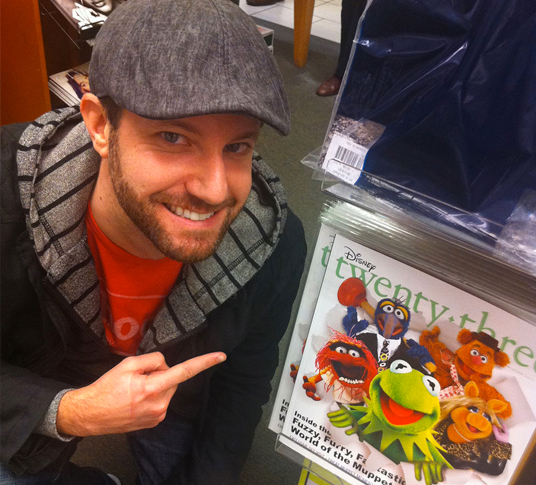
“When I started my job with Disney I never thought I’d be a part of something like D23. After 21 issues of Disney twenty-three magazine (working on 22 and 23 now!), I think my favorite was probably Winter 2011, when the Muppets made their return to the big screen and graced our cover. I am a huge fan of Kermit and the gang, and as I was designing the cover for that issue, I got the crazy idea of making our entire cover, and each Muppet, felt. It turned out to not be entirely feasible for various reasons, but we were able to make the entire back cover and our masthead fuzzy and Kermit green. The entire printer that produces twenty-three was covered in fuzz! That issue still sits on my coffee table… one of probably 20 Kermit’s found in my office.”
—Jared Cohen-Richards, Art Director, Disney twenty-three
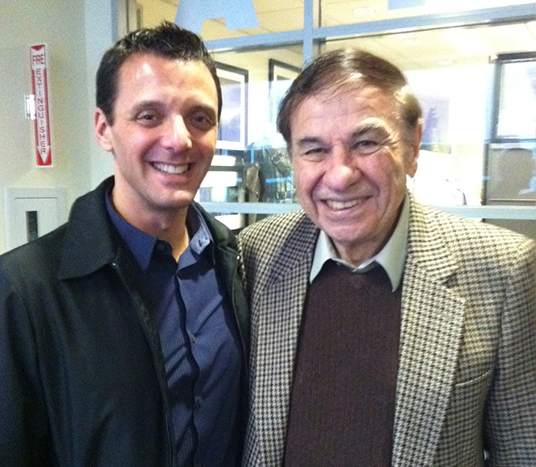
“One of the things I love doing at D23 is taking our members on our tours of the Walt Disney Studio Lot and Archives. Being a huge Disney fan myself, sharing the heritage of Disney with people who embody that same enthusiasm is incredible. We’re always looking at ways to make the tours even better, whether that be through personal anecdotes or new, fun facts we learn. I was treated to both several years ago. We had just had a member event on the lot, and several of us were walking Disney Legend Richard M. Sherman and his wife, Elizabeth, back to their car from the Studio Theatre. On the way, we passed the Shorts Building—actually two buildings that were moved over from the when the Studio was located on Hyperion Avenue in the Los Feliz neighborhood of Los Angeles and then connected. As we passed, Richard turned to me, pointing up to a corner window and said, “That’s where my brother and I had our office. Walt would come there and give us notes.” Now it’s one thing to learn a fact about something by reading it in a book, but to have Richard himself point up to that window and tell me that little tale was an entirely different thing. It completely enriched my love for the legacy of our company, and it gave me a terrific story to share with D23 Members whenever I give a tour.”
—Jeffrey Epstein, Marketing and Publicity, D23
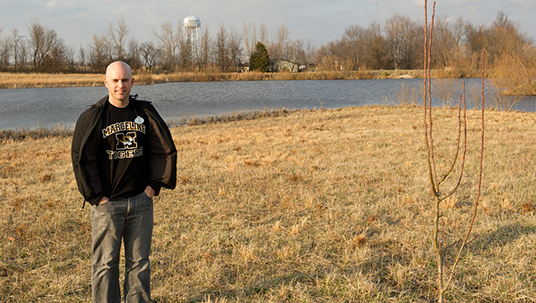
“On March 14, 2012, 100 eager D23 fans boarded a chartered bus in Kansas City, Missouri to travel back in time to a place that Walt Disney would always call his home.” D23’s Journey to Marceline celebrated the memories of Walt’s hometown with a one-of-kind tour experience that included a visit to the Walt Disney Hometown Museum, a screening at the Uptown Theatre, and a sunset reception at the Disney farm. The mayor came out to officially proclaim March 14th as D23 day in city of Marceline. This special event brought to life Marceline’s rich Disney heritage and left guests, including myself, with one unforgettable day that we’ll always cherish. ”
—Michael Buckhoff, Archivist, Walt Disney Archives
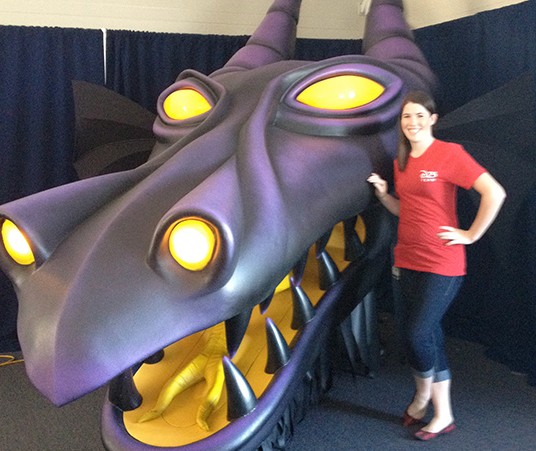
“Many D23 Members have told me that they have ‘Disney bucket lists,’ or a list of fantasy experiences they’d love to have with Disney. Ever since I was a little girl, mine has been to take a peek behind the scenes of Fantasmic! At Disneyland Park. There’s something about the storytelling and magic of the show that absolutely never gets old, and I’m quick to tell people that it’s my favorite ‘Disney thing’ of all. So when I got the opportunity to escort the old Maleficent dragon prop from the show from to its new home at Treasures of the Walt Disney Archives at the Ronald Reagan Presidential Library, it was a dream come true. That’s what I love most about D23, the incredible opportunity we have to bring fans up close and personal with whatever it is they love most about Disney. It’s been such a privilege to help our members check items off their Disney bucket lists, and in the process I’ve gotten to check some items off mine too!”
—Kelly Griffiths, Marketing, D23
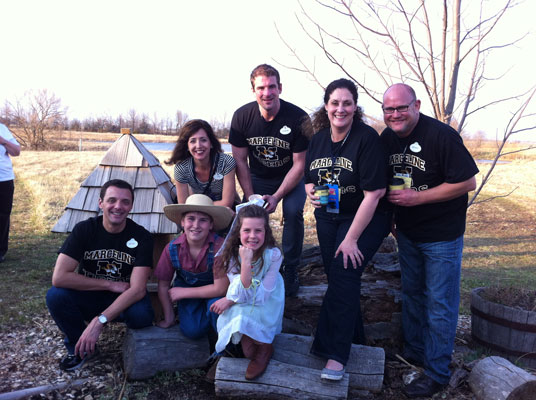
“Visiting Marceline Missouri was an amazing experience! I was born and raised in Los Angeles so I was immediately caught up in the small town charm of Marceline, and a bit jealous of how close people there are. Add to that the fact that the town has this wonderful Walt Disney history (that they are extremely proud of) and it just all made for a great visit! This photo is some of our team that went out for the event and young ‘Walt’ and his sister ‘Ruth.’ They were great kids and in addition to their starring roles, they also acted as our tour hosts. Loved this place and hope to go back someday!”
—Toni Wehn, Special Events, D23
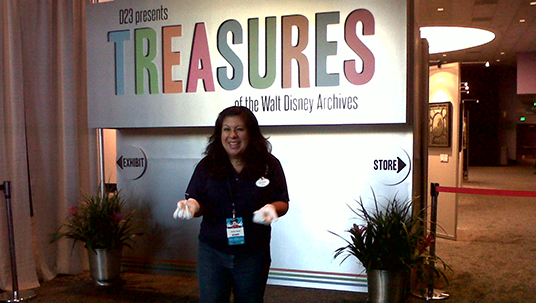
“Here is a pic of me out front of the entrance to the exhibit from D23 Expo 2011. It was my first time assisting our team with setting up an actual exhibit other than my usual ordering of supplies so it was a really big honor for me to experience it all.”
—Alesha Reyes, Administration, Walt Disney Archives
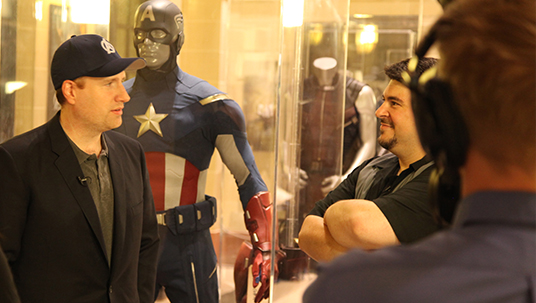
“Over the 4 years that I’ve been with D23, I have been given the opportunity to have so many fantastic adventures, doing things I never thought, as a Disney fan, Id get to do. From hearing Julie Andrews speak words that I wrote, to traveling to New York City with Billy Stanek while we did a whirlwind tour of Good Morning America, Newsies, and The Lion King, it has truly been a dream come true. But for this fanboy, my best memory of my time with D23 has to be the evening we shot the Avengers episode of Armchair Archivist. In the weeks leading up to the shoot, we were told that Marvel Studios President Kevin Feige would have only a few minutes to talk to us in between giving presentations at USC’s school of cinematic arts. So we were prepared… questions prepped, shots planned, we were ready to go. When Kevin arrived, we instantly struck up a conversation and before we knew it, we had spent 15 minutes just chatting about movies and Disney (Kevin is a Charter member of D23!), fearing we were going to run out of time to shoot the episode, we rolled camera, and what you see in the final episode is literally just two movie fans talking and looking at props. He was so gracious with his time, even coming up with an idea for a Marvel-esque post credits scene for the episode. It was truly once and a lifetime and after 16 years in the business, its a shoot that I hold at the top of my list. It wasn’t until after, that I realized, the experience I had with Kevin, is exactly what D23 is all about, bringing the fans closer to the movies, music and the wonderful world of Disney than ever before. And in that moment, I was the biggest fan of them all.”
—Josh Turchetta, Host, Armchair Archivist
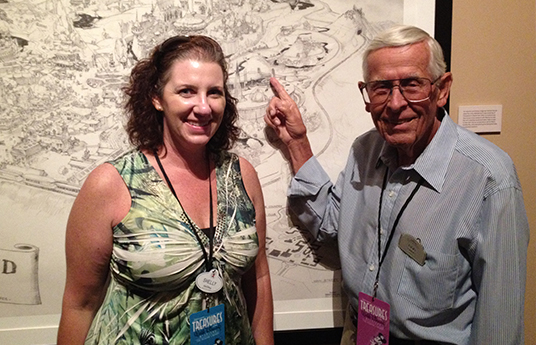
“When I see Bob Gurr, I like to remind him that before I worked in the Walt Disney Archives, I used to drive the Mark V Monorail trains at Disneyland. He likes to reply, ‘But I drove the FIRST one!’ In this photo, we are inside our Treasures of the Walt Disney Archives exhibit at the Reagan Library on opening day July, 2012, and he’s pointing out the concept for The Disneyland-Alweg Monorail System in Tomorrowland on the map. I think my experience as a 20-year cast member has now come full-circle! Thanks D23 for the fun memories I will never forget!”
—Shelly Graham, Walt Disney Archives
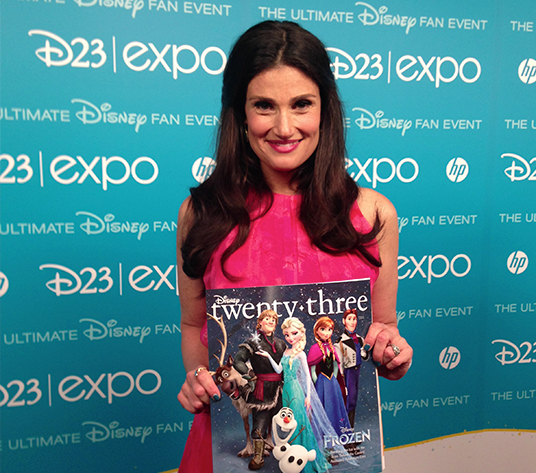
“As part of the D23 social media team, I really loved being a part of the D23 community and interacting with many of you behind the scenes. Although I had fun all year long, the D23 Expos were always a special time since we got to share some really awesome and exclusive content—I’m pretty sure most jobs don’t require hanging backstage with celebrities like Robert Downey, Jr. Jason Segel, Anika Noni Rose, and countless others! My favorite moment this past D23 Expo was meeting Idina Menzel and taking this picture for the D23 social media accounts—I had always been a huge fan of her so meeting her and seeing her perform was an unforgettable experience. Thank you for the memories, D23!”
—Patricia Sheppard, Manager, D23.com and Social Media
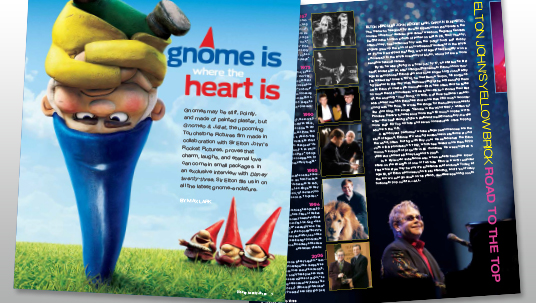
“It’s not every day you get a phone call from Sir Elton John, but I was fortunate enough to enjoy that once-in-a-lifetime moment in 2011 when I was writing the story “Gnome is Where The Heart Is” for the spring 2011 issue of Disney twenty-three. I’m dating myself, but Elton John was the first concert I ever saw, in 1974—an event that left an indelible impression on me—so when I picked up the phone for our interview and heard, ‘Hello Max, this is Elton,’ I was pretty much floored. And wondering how it could be possible that I had made the journey from Detroit and the upper deck at Olympia Stadium to Los Angeles and this unforgettable moment talking to Sir Elton.”
—Max Lark, Editor in Chief, Disney twenty-three
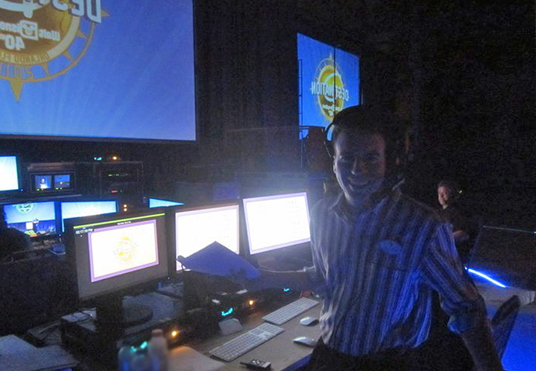
“Take the thrilling feelings you get on the last day of school, at a wedding, and, well, on a trip to Walt Disney World Resort, blend them together, and that’s how many of us felt on May 14 and 15, 2011, as we gathered to celebrate 40 years of Vacation Kingdom memories at Destination D: Walt Disney World 40th. During this weekend event, Disney Legends, Imagineers, entertainers, Cast Members and, most importantly, 1,200 D23 members and their Guests commemorated the fascinating development and evolution of the Florida Project with rare, behind-the-scenes glimpses. Although most of my work was done behind the curtain, helping produce and operate the show, my heart was among D23 members (and my family!) in the audience. Who can forget the musical finale uniting Richard Sherman, Dreamfinder and Figment, the Main Street Philharmonic, the Kids of the Kingdom, the Encore! Cast choir and band, and other celebrated performers from Walt Disney World past and present? What a weekend!”
—Steven Vagnini, Archivist, Walt Disney Archives
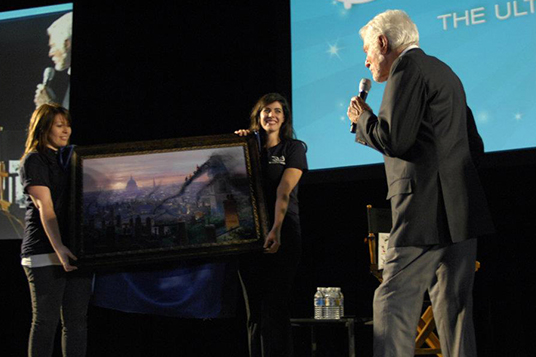
“My favorite D23 moment was at D23 Expo 2011. There was so much to help with behind-the-scenes to make the expo a great event that I didn’t really expect to see any of the great panels or performances scheduled for the weekend. I ended up being in the right place at the right time though, and was pulled up on stage to help present a painting to Dick Van Dyke. Later, I had the privilege of getting to talk with him a bit more after his performance. I grew up watching his movies and TV show, so it was very surreal (and awesome!) to meet him in person.”
—Francesca Cramer, Administration, D23

“A little bit of rain wasn’t going to dampen my mood in January 2012. I was on my way to interview to Dick Van Dyke—a renowned actor and Disney Legend that I’ve admired since I was a child. Who wouldn’t be excited? I stepped inside a voice-recording studio for the very first time—which was super cool in and of itself!—and immediately heard a very familiar voice singing a song. I quickly made my way over to the control room of the studio, and there he was—Bert himself, Dick Van Dyke! I was able to watch him voice a brand-new character for Disney Junior, and after he was finished, I met him inside the sound booth for an interview. It was one of those pinch-me moments that I’ll never forget, and one of the things that I love about my job at Disney.”
—Cynthia Momdjian, Writer, D23.com and Social Media
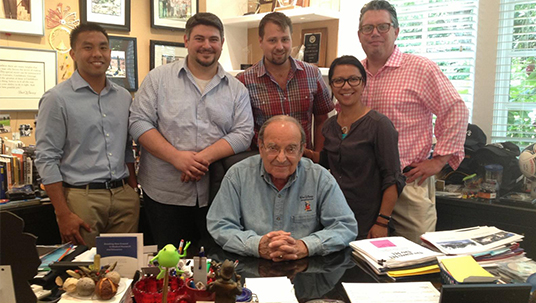
“Last April D23 sat down with Marty Sklar for an interview about his book Dream It! Do It!: My Half-Century Creating Disney’s Magic Kingdoms. I was privileged to be a part of the crew that was invited to his house to capture footage for D23.com, which I know many of you have seen. I normally don’t get the chance to go out on video shoots, so when I was asked to go I got really excited. Meeting Marty for the first time and hearing him speak about his storied career that April morning definitely makes it at the top of my list for favorite D23 moment.”
—Cris Bernabe-Sanchez, Graphic Designer, D23
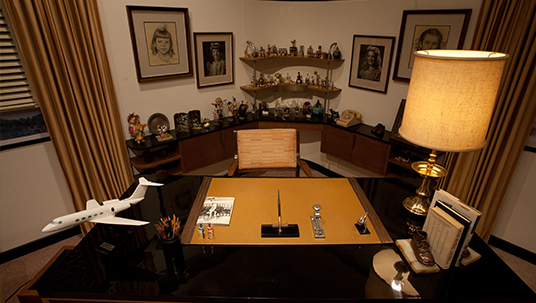
“Books. Carpet. Decorations. Furniture. These everyday things populate our daily lives to some degree, be it at work, at home, at play, or on the go. However, it’s not everyday that one has the chance to showcase and reassemble a collection of these effects from the Burbank studio office of Walt Disney. During the Walt Disney Archives’ preparation for D23 Presents: Treasures of the Walt Disney Archives at the Ronald Reagan Presidential Library and Museum, the Archives staff spent many hours resetting nearly every piece of ephemera from Walt’s Formal Office in a recreated exhibit space at the museum. This process was exceptionally rewarding, and helped the entire staff experience a further and deepened sense of respect for Walt, the man. However, for me, the most rewarding part of the entire (and lengthy) installation process was seeing our guests’ reactions when the exhibit doors opened for the gala grand opening, allowing all to experience our recreation of Walt’s Formal Office in its finished state. That one moment, watching as a mixture of delight and reverence swept across the excited audience filled with D23 Members and special guests, is something I’ll never forget.”
—Kevin Martin Kern, Collection Specialist, Walt Disney Archives
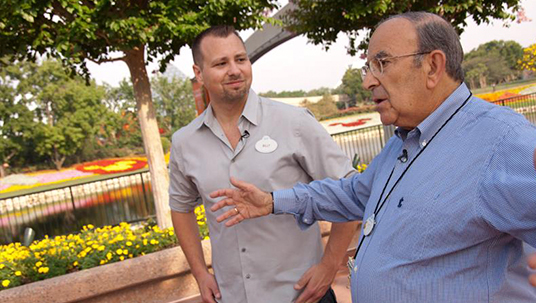
“It doesn’t get any better than spending a morning with Marty Sklar. And if you were with us at D23’s Destination D Walt Disney World 40th Anniversary event then you know exactly what I am talking about. Marty was there for two days of panels and presentations about the resort’s history. This Disney Legend worked side by side Walt Disney throughout his career, and was tasked with making Walt’s final dream—E.P.C.O.T.—a reality, which I should also admit is my favorite Disney park. While most of my time is spent behind a computer or iPhone bringing Disney fans the latest news and stories from the archives, I often get to step out of the office and experience Disney and hear from its creators firsthand, along with you. Thanks for letting me be a part of your Disney fan club.”
—Billy Stanek, Editor, D23.com and Social Media
Take a Look Back at Disney in the Year 1923
Walt (right), just months after arriving in California.
He’s with brother Roy in front of their first Hollywood Studio, on Kingswell Avenue.
1923.
In the glow of prosperity following World War I, America as never before sees itself as the land of opportunity, especially through the eyes of its youth. Many young fortune-seekers head for the Big City—Hollywood—glamorous home of the movies that are lighting up the silver screen, attracting one third of the nation to theaters at least once a week. Anything seems possible.
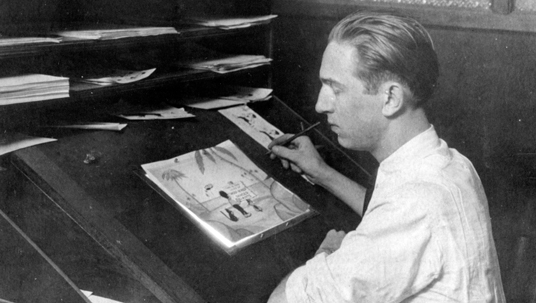
For a young cartoonist named Walt Disney, 1923 starts on a note of failure. His Kansas City animation studio, Laugh-O-gram Films, was foundering less than a year after its May 1922 incorporation. The Tennessee-based distribution company funding the six animated fairy tales Walt had created with a small group of young artists had gone belly up, and Laugh-O-gram was in danger of going bust itself.
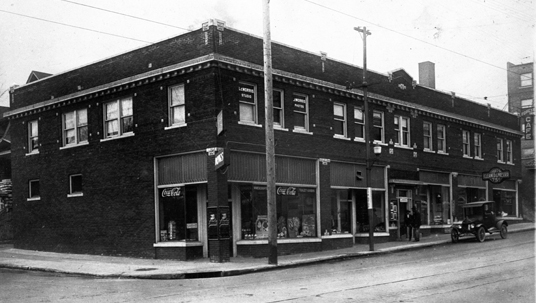
Not that any of this deterred the young Walt. Like a Horatio Alger hero sprung to life, he brimmed with self-confidence and get-up-and-go, an innovative spirit that personified 1923’s youthful zeal. Walt’s older brother Roy, who was then convalescing from tuberculosis in a Los Angeles veterans hospital, later said his 21-year-old brother “had a persistency, an optimism about him, all the time. A drive.”
Daringly, in light of his studio’s free-fall, Walt spent the early months of 1923 attempting to create a new animated series. “I was desperately trying to get something that would take hold, catch on,” he said. The imaginative Disney hit upon a “reversal” of Max Fleischer’s popular Out of the Inkwell cartoons, which featured the animated Koko the Clown running amuck in the real world. With his usual flair for the technically innovative, Walt would produce a short incorporating a live action little girl in an all-cartoon world.
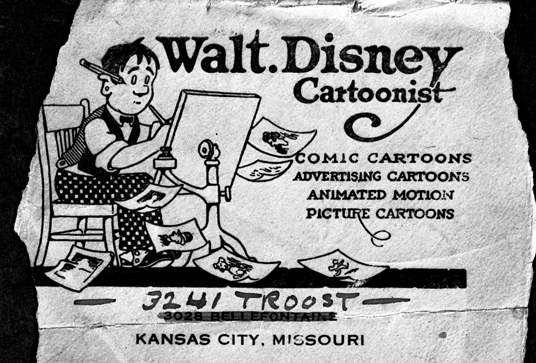
“We have just discovered something new and clever in animated cartoons!” Walt trumpeted in a letter to New York distributor Margaret J. Winkler about the Alice in Cartoonland concept. Though Miss Winkler expressed interest, only half the film was completed before money ran out entirely. Walt tried other projects, but it was no use: His employees abandoned ship, and with no money to live on, Walt slept in the Laugh-O-gram office, ate on credit at the small Forest Inn Café downstairs, and bathed once a week at Union Station for a dime. Finally a concerned Roy advised, “Kid, I think you should get out of there.”
That did it. Walt declared bankruptcy and joined Roy in sunny Los Angeles. He bought a train ticket: first class.
“Walt always had to have the best,”
noted his wife, Lillian, in telling the story years later. “I was in my pants and coat that didn’t match,” Walt later reminisced, “but I was riding first class.” The westbound young man departed Kansas City in July, and for Walt, a lifelong railroad enthusiast, the trip to Los Angeles was a thrill: “It was a big day, the day I got on that Santa Fe, California Limited.” And there was the gleaming promise of a shiny new start in Hollywood, already the fabled land of dreams-come-true.
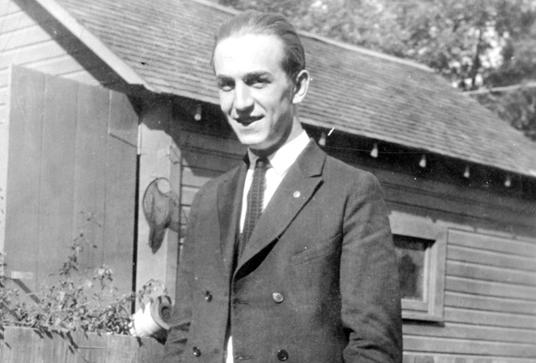
Arriving in Los Angeles, the once-and-future cartoonist rented a room from his uncle Robert Disney, and, although he had included drawing materials among his few belongings, he said, “I was fed up with cartoons. My ambition at that time was to be a director.” The young hopeful hopped a bus for the movie studios and, following job interviews, hung out around the dream factories, keenly observing how scenes were staged and shot. Years later Walt recalled watching Western director William Beaudine in action. He would later direct “The Adventures of Spin and Marty” for TV’s Mickey Mouse Club in 1955.
But when Walt failed to land a movie studio job, he decided to tackle animation once again. In his Uncle Robert’s garage, Walt cobbled together an animation stand out of spare lumber and old boxes. On August 25, Walt wrote Margaret Winkler, saying he was in the process of “establishing a new cartoon studio” and suggesting she screen the unfinished Alice’s Wonderland. Disney’s initial faith in Alice suddenly paid off: Miss Winkler telegraphed Walt on October 15, offering a contract. Jubilant, Walt burst in upon his brother in the veterans hospital late that night to show Roy the telegram and urge him to jump aboard. Roy signed himself out of the hospital the following day, October 16, 1923, the same day Walt signed what Disney Chief Archivist Dave Smith describes as “the most important document in the history of The Walt Disney Company”: a contract for a series of Alice Comedies, the start of the Disney Studio.
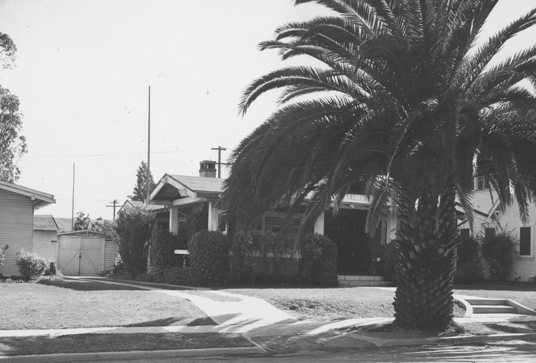
With funding from Uncle Robert, Walt rented space in the back of a real estate office. By the time Walt celebrated his 22nd birthday on December 5, production was almost complete on Alice’s Day at Sea (he drew the animation entirely himself), and the finished short was delivered on December 26. By January 12, 1924, Roy had paid off the debts to Uncle Robert, and the Disney Bros. Studio moved to a next-door storefront by mid-February.
As 1923 became 1924, Walt Disney’s pioneering spirit was already clearly evident. Walt famously said, “it all began with a Mouse”—but it really all began with the ambition, imagination, and passionate dedication to quality of the youthful go-getter who journeyed not just to Hollywood but beyond… to the creation of a new, inspiring, and inclusive entertainment form called Disney.
And it all began in 1923.
Acme Archives Discount
Where
Online at AcmeArchivesDirect.com and DarkInkArt.com
What
20% off your entire purchase
When
Expires December 31, 2021
Acme Archives Ltd. is pleased to offer D23 members a 20-percent discount on all purchases made via AcmeArchivesDirect.com and DarkInkArt.com
Official fine-art licensee for Disney/Lucasfilm, 20th Century Fox and other pop culture properties, ACME Archives Ltd. proudly presents the finest-quality studio and interpretive art by a roster of top-shelf talent, reproduced as highly collectible limited editions on museum-grade archival canvas and paper. ACME products also include fine art lithographs, silk screen prints, mini canvas print Gems and collectible pins.
To receive your discount, just enter DISD23 at checkout!
Some of the latest and greatest art from Acme Archives features artwork by Brian Miller, Cliff Cramp, Danny Haas, Steve Thomas, J.J. Lendl, Dave Perillo, Tom Whalen, Matt Ferguson, Jeremy Saliba, Craig Skaggs, Mike Kungl and more!
NOTE: This offer cannot be combined with any other discount or coupon.
Name That Oscar-Winning Movie
Walt Disney personally stacked up an impressive 32 Academy Awards®—by far a record for any single individual. Below we have photos from the 27 feature films and shorts for which he won awards (we are not including “special” awards such as those won for the creation of Mickey Mouse, Snow White and the Seven Dwarfs, or the Multiplane Camera).
See if you can name each movie, based on the image. Answers and scoring are at the bottom. In the answers, we’re also including the year each project was released as well as for what it won its award. Good luck! And don’t forget to tune in to see who takes home the prizes this year when ABC airs the Academy Awards on Sunday, February 28.
1.
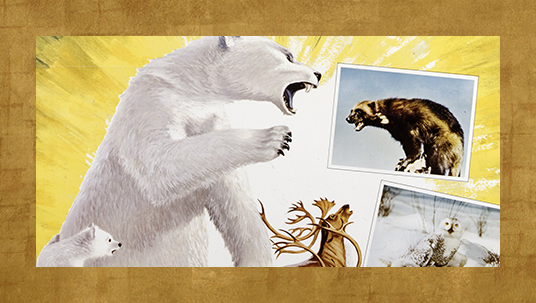
2.

3.
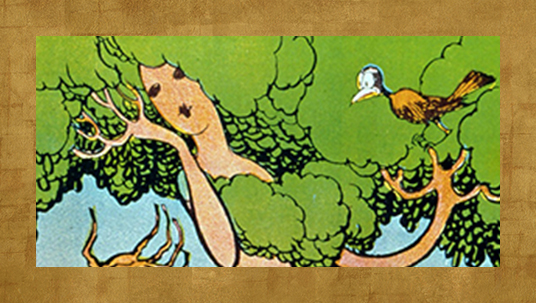
4.
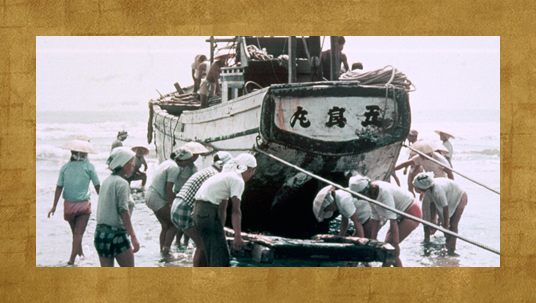
5.
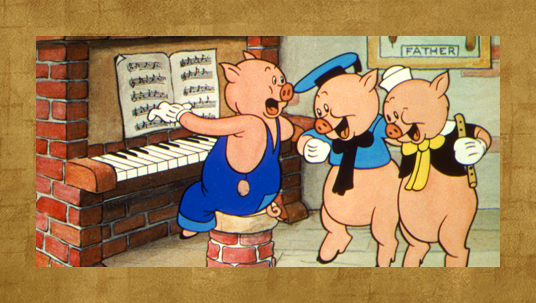
6.
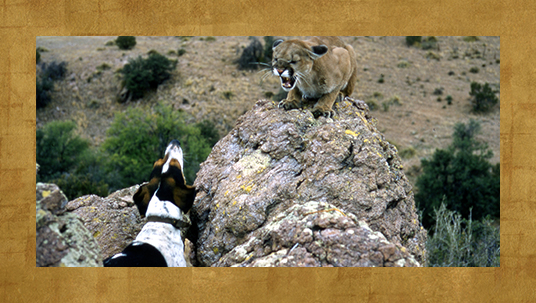
7.
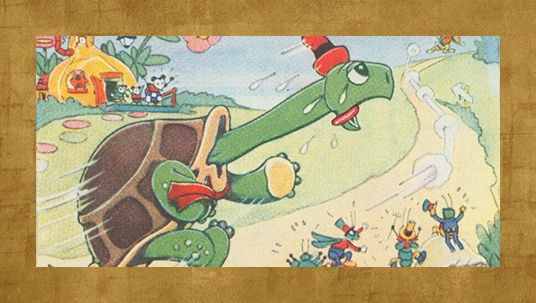
8.
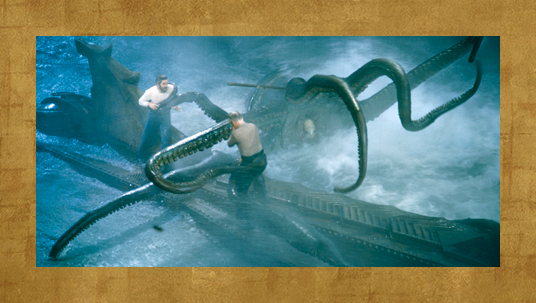
9.
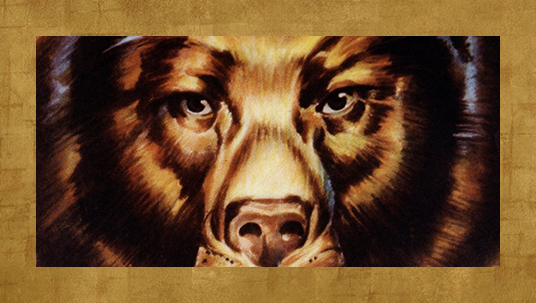
10.
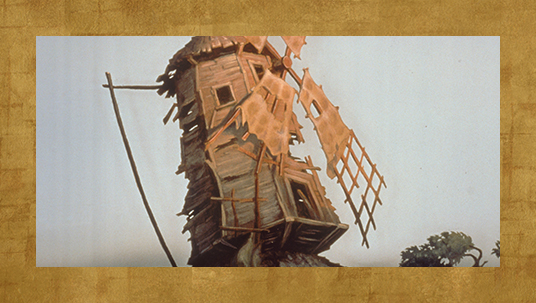
11.
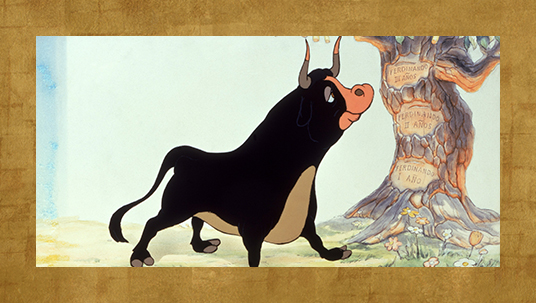
12.
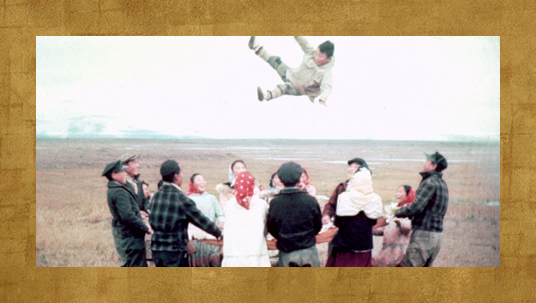
13.
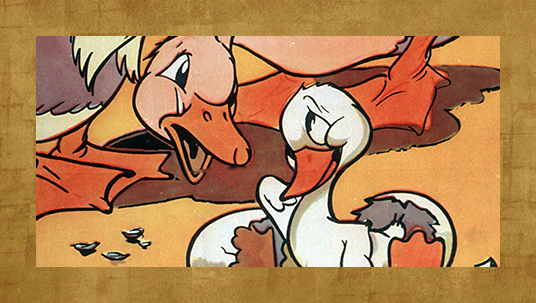
14.
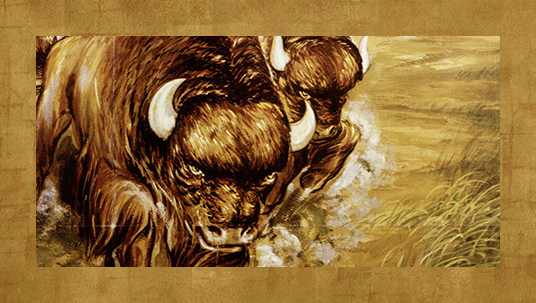
15.
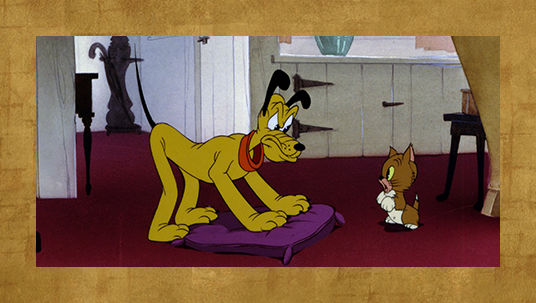
16.
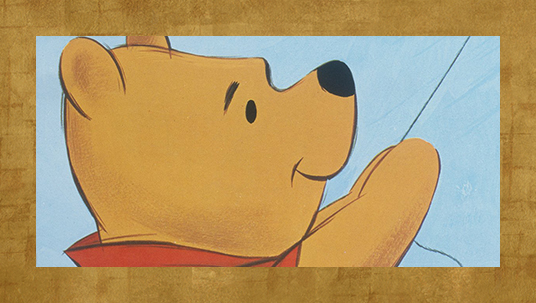
17.
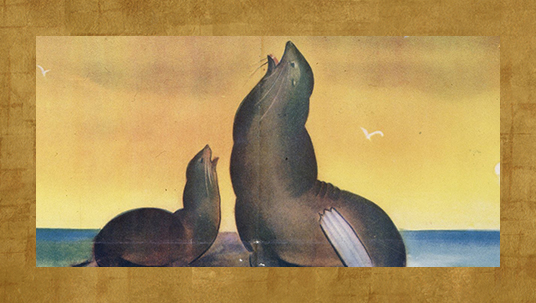
18.

19.
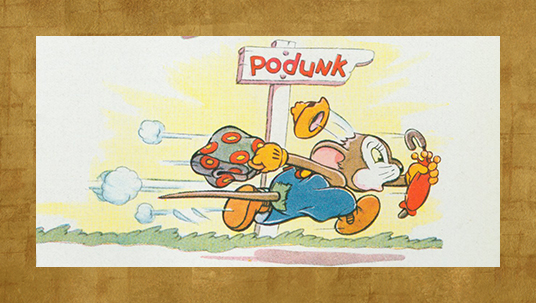
20.
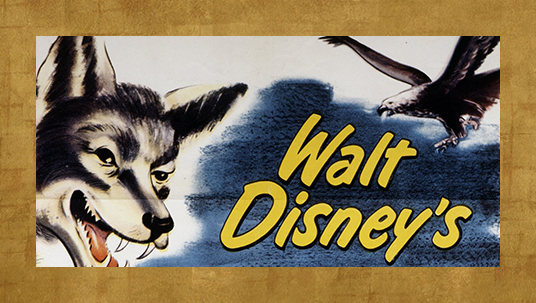
21.
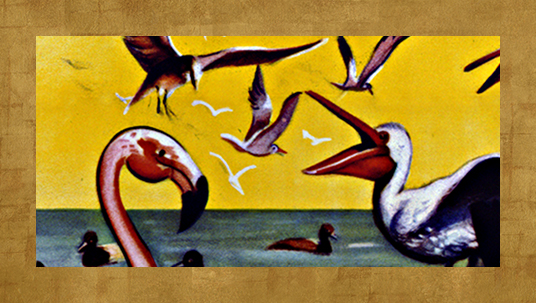
22.
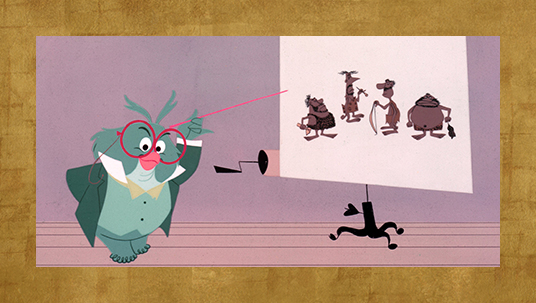
23.
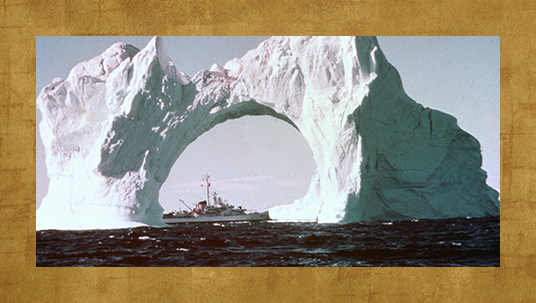
24.
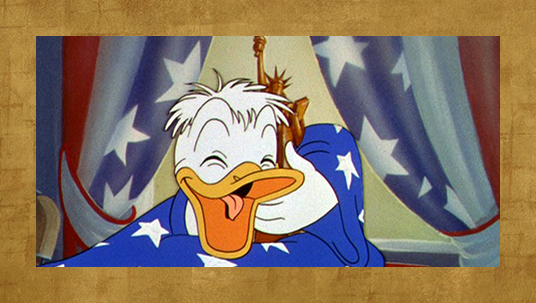
25.
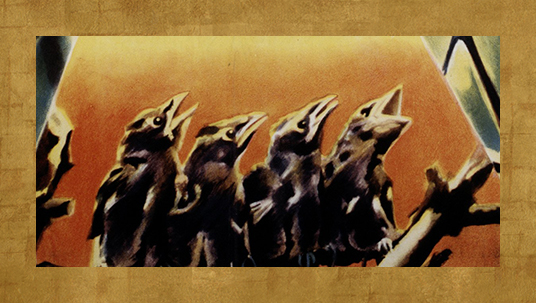
26.
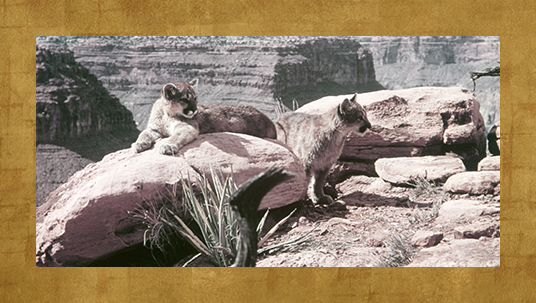
27.
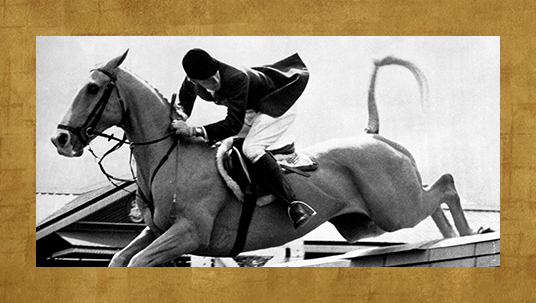
ANSWERS
1. White Wilderness (Documentary Feature, 1958)
2. The Living Desert (Documentary Feature, 1953)
3. Flowers and Trees (Cartoon Short Subject, 1931-32)
4. Ama Girls (Documentary Short Subject, 1958 – Walt Disney, Executive Producer; Ben Sharpsteen, Producer)
5. Three Little Pigs (Cartoon Short Subject, 1932-33)
6. The Wetback Hound (Live-Action Short Subject, 1957 – Walt Disney, Executive Producer; Larry Lansburgh, Producer)
7. The Tortoise and the Hare (Cartoon Production, 1934)
8. 20,000 Leagues Under the Sea (Achievement with Special Effects, 1954)
9. Bear Country (Two-Reel Short Subject, 1953)
10. The Old Mill (Cartoon Short Subject, 1937)
11. Ferdinand the Bull (Cartoon Short Subject, 1938)
12. The Alaskan Eskimo (Documentary Short Subject, 1953)
13. The Ugly Duckling (Cartoon Short Subject, 1939)
14. The Vanishing Prairie (Documentary Feature, 1954)
15. Lend a Paw (Cartoon Short Subject, 1941)
16. Winnie the Pooh and the Blustery Day (Cartoon Short Subject, 1968 – Walt Disney, Executive Producer — awarded posthumously)
17. Seal Island (Two-Reel Short Subject, 1948)
18. Three Orphan Kittens (Cartoon Production, 1935)
19. The Country Cousin (Cartoon Short Subject, 1936)
20. Beaver Valley (Two-Reel Short Subject, 1950)
21. Water Birds (Two-Reel Short Subject, 1952)
22. Toot, Whistle, Plunk & Boom (Cartoon Short Subject, 1953)
23. Men Against the Arctic (Documentary Short Subject, 1955)
24. Der Fuehrer’s Face (Best Cartoon Short Subject, 1942-43)
25. Nature’s Half Acre (Two-Reel Short Subject, 1951)
26. Grand Canyon (Live-Action Short Subject, 1958)
27. The Horse With the Flying Tail (Documentary Feature, 1960 – Walt Disney, Executive Producer; Larry Lansburgh, Producer)
SCORING
0 – 5 Correct: Aspiring Archivist
You’ve given it your best, but you’re going to need to brush up on your Disney film history before going head-to-head with Disney Legend Dave Smith.
6 – 15 Correct: Film Fan
You definitely have more Disney film knowledge than the average fan. Unlock your inner expert by re-watching your classic Disney films.
16 – 22 Correct: Supercali-smartypants
Well done! You’re on your way to becoming a Disney film expert. Next time be sure to brush up on Disney A to Z and the Characters section of D23.com to earn a perfect score!
23 – 27 Correct: Supreme Sorcerer
You’ve earned your sorcerer’s hat with your superior knowledge of Disney films! Way to go!
Mickey Mouse Wore Green Shorts and Yellow Gloves In His Color Debut
Mickey’s true color debut came in 1932’s Parade of the Award Nominees, a short film made for that year’s Academy Awards banquet. Wearing green shorts and yellow gloves—a standard color scheme on many toys at the time—Mickey led Minnie, Clarabelle Cow, and the Oscar nominees of 1932 as they marched through a fairytale forest. Marie Dressler (Emma) brought up the rear, carrying a suitcase from which a stray alarm clock dragged. A gray-furred, oddly monochromatic Pluto sniffed along the clock’s trail, just as he’d tracked a similar clock in Just Dogs (1932).
But then why is The Band Concert often referred to Mickey’s first appearance in color?
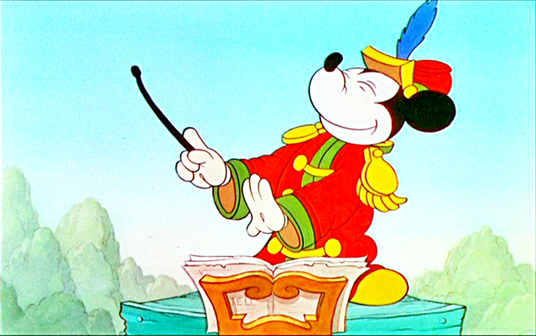
Award Nominees may have beaten The Band Concert to the color punch. But Band Concert was the first regular Mickey cartoon in color—and comparing it to Award Nominees shows us just what decisions were involved in adapting to color on a more permanent basis.
Mickey’s shorts had been both red and green in merchandise, but they were more often red, so Band Concert decisively made red Mickey’s signature color. In another change from Award Nominees, no character in Mickey’s Band Concert world was gray anymore. In 1935, Disney held an exclusive contract on Technicolor’s three-strip process, giving him more colors to work with than other studios had. Why not indulge? Indeed, The Band Concert‘s color level was matched only by its excitement level!
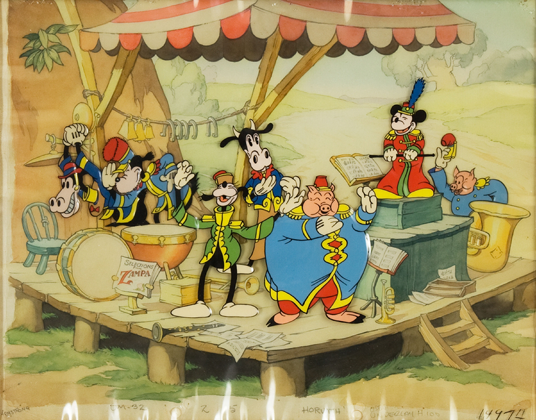
When 1940s bandleaders spoke of “Mickey Mouse music,” it wasn’t a compliment. They were simply referring to trite, noisy dance-band tunes that brought generic cartoons to mind. Of course, we know that classic Mickey cartoons were never generic, nor were their scores! Mickey himself was often shown as a genuinely cultured “performer” and real Mickey Mouse music—as orchestrated by studio musicians like Carl Stalling and Leigh Harline—covered everything from bracing classical tunes to vibrant jazz. In 1935, Gioachino Rossini’s “William Tell” overture provided the theme for Mickey’s most memorable musical epic: The Band Concert!
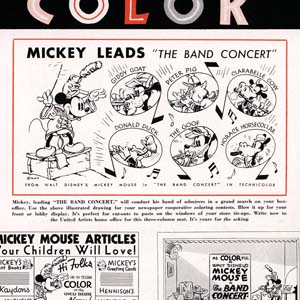
The story finds Mickey’s orchestra performing in the park; the group includes conductor Mickey, Goofy on clarinet, Clarabelle on flute, Horace on drums, Peter Pig on trumpet, little Paddy Pig on tuba and a whiskery dog on trombone. Finishing Louis Hérold’s “Zampa,” the band begins “William Tell,” but is heckled by snack salesman Donald Duck. Playing “Turkey in the Straw” on a fife, Donald tricks the band into playing it too! Irate Mickey breaks Donald’s fife, but the Duck has an unending backup supply. Then two other menaces confront the band: a pesky bee and a raging cyclone that carries Mickey’s gang into the sky. But gutsy Mickey finishes the midair overture and brings everyone down to earth, even if only Donald is left to cheer.
Helmed by future Snow White director Wilfred Jackson, this storyline brought out the best in Disney’s staff—and his stars. Animator Les Clark recalled being put in charge of Mickey because some of his peers’ Mickeys were “stiff and had no fluidity.” Clark’s bouncier Mouse was perfect for Band Concert; as he fought to conduct his motley crew, his frustration—with Donald, with everything—became sympathetic as well as funny. But Dick Huemer’s Donald was sympathetic, too. Mugging gleefully at viewers, Donald hinted that Mickey’s overachieving gang was just asking to be pranked… and audiences had to agree! Icing on the cake was Ferdinand Horvath’s opening scene, introducing the band with the perfect mix of pomp, energy, and silliness. Famed illustrator Horvath, better known as a concept artist, got a plum of an animation assignment.
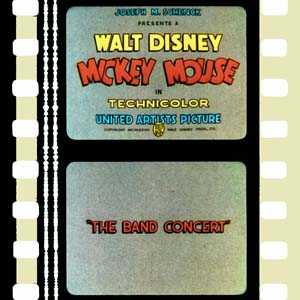
The Band Concert was a plum itself. Mickey’s full-time switch to color made Disney the first all-color cartoon studio; a milestone emphasized in a special bulletin from distributor United Artists. The bulletin was followed by an oversized press kit, laden with detail—and a few bloopers: Giddy Goat, a bumpkin bit-player from the comics, was announced as part of Mickey’s band, even though he was replaced by the dog trombonist in the film. Other aspects of the press kit are equally amusing to modern eyes, including the suggestion that paint stores cross-promote the film with their products—all the better to sell color to viewers. The press was sold, too. The New York Times admired “Mickey Mouse fall[ing] under Technicolor’s sway.” Vogue magazine noted that “we shall not soon forget the epic figure of Horace at the kettle-drums in The Band Concert…” The film was still a legend years later, leading to its reissue with refilmed opening titles. Modern TV and video releases use the reissue print, so fans generally haven’t seen the original title designs since the 1930s.
Music, Mousetro—please!
Take a Time-Traveling Road Trip With Walt Disney on the Magic Skyway
Walt Disney’s Magic Skyway at the Ford Wonder Rotunda was the 4th most-attended attraction at the 1964–65 New York World’s Fair, hosting almost 15,000,000 guests. At the close of the fair, Walt hoped to bring the Skyway back to Disneyland, but it was not to be.
See More in the Spring Issue of Disney twenty-three ►
And so the largest Disney ride ever built during Walt’s lifetime became the stuff of legend. Return with us now to those thrilling days of yesteryear, when from out of the past comes the thundering roar of a 271-horsepower Mustang engine, and the Magic Skyway rides again!
Now it’s your turn to step into a brand new Ford convertible, sit back, and let Walt Disney be your guide to a distant past and a future yet to come!
Urban planning and modes of transportation had long held an interest for Walt, and before there was a Magic Skyway there was Magic Highway U.S.A., an episode of the Disneyland television show that first aired on May 14, 1958. Tracing the history of the automobile and the highway system, Magic Highway U.S.A. envisioned fantastical new modes of transportation, noting that, “such visionary ideas which today seem sheer fantasy will be commonplace to future generations.”
To turn fantasy into reality, Disney artists, in collaboration with architect Welton Becket, began to conceptualize the form of the Ford pavilion for the 1964–65 New York World’s Fair, eventually designing a Wonder Rotunda defined by 64 100´ pylons, encircled by two glass-enclosed skyways.
Inside the Wonder Rotunda, guests waiting in line could experience the full gamut of Ford’s inventiveness—from the 1896 Quadricycle to 1964’s Mustang (which made its debut at the Fair). Guests could also explore a village in miniature, the International Garden of the Wide World of Ford, commemorating 300,000 Ford men and women in more than 50 Lands, uniting the world’s skills in science, art, and commerce.
After embarking in one of more than 100 latest model Ford convertibles, guests traveled far back in time.
There they encountered the forest primeval, dinosaurs, and the dawn of man.
Hurtled forward in time, guests were given a glimpse of the future as they toured Space City. (Magic Skyway‘s vision of the future was shaped in large part by Magic Highway U.S.A., whose promotional art we see above.) The entire ride traversed more than 100,000,000 years in just twelve minutes!
Safely disembarking back in New York of 1964, visitors were afforded the opportunity to explore Fields of Science (also called Adventures in Science), a separate exhibit illustrating “some of the advanced research projects now engaging scientists at Ford and its subsidiary, Philco.”
Having sketched, painted, and crafted intricate models, the time had come for Walt’s Imagineers to turn their dream into a reality. The Walt Disney Studio’s Burbank backlot quickly filled up with dinosaurs and cavemen—a total of 68 Audio-Animatronic figures were created for the Ford pavilion alone!
When finally completed, the Ford Wonder Rotunda used 3,000 tons of steel and 35,000 square feet of architectural plate glass to enclose its 273,000 square feet. More than 4,000 guests an hour traveled the half mile Magic Skyway, experiencing sights and sounds previously unheard by any living human being.

When Ford’s Magic Skyway opened on April 14, 1964, the original narration included only a small contribution from Walt. New narration (which you’ve just heard) was written and recorded for 1965. Let’s climb into our time machine once more and listen in as Walt records the new Magic Skyway narration, aided by its author, a young Marty Sklar.
And the next time you ride the Disneyland Railroad, be sure to say “howdy” to all the dinosaurs from the Magic Skyway who now make their home in Primeval World Diorama!



